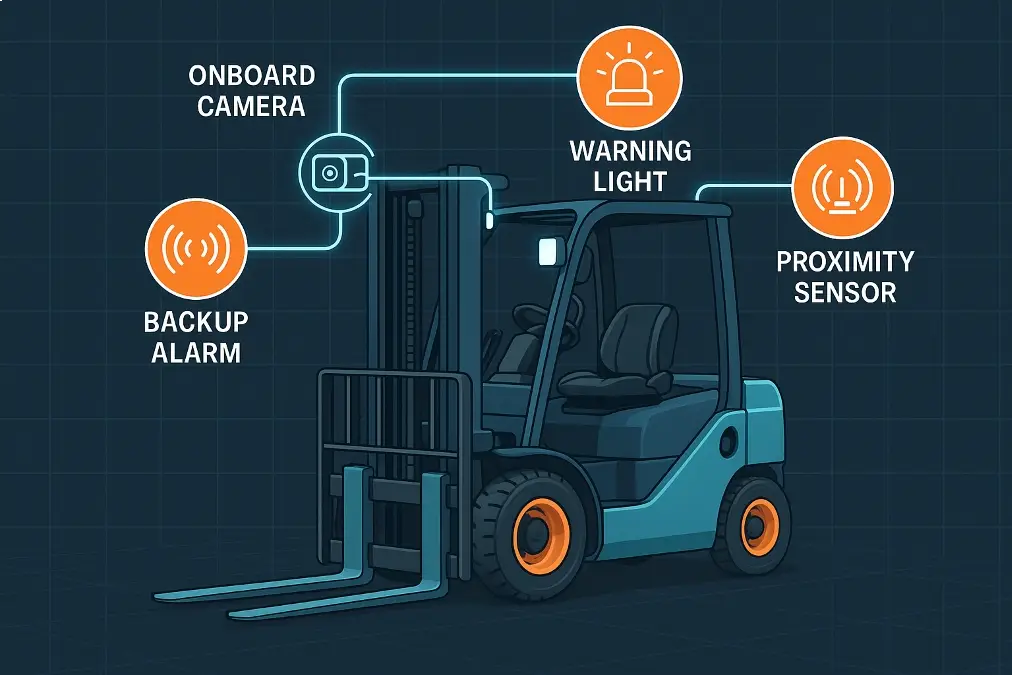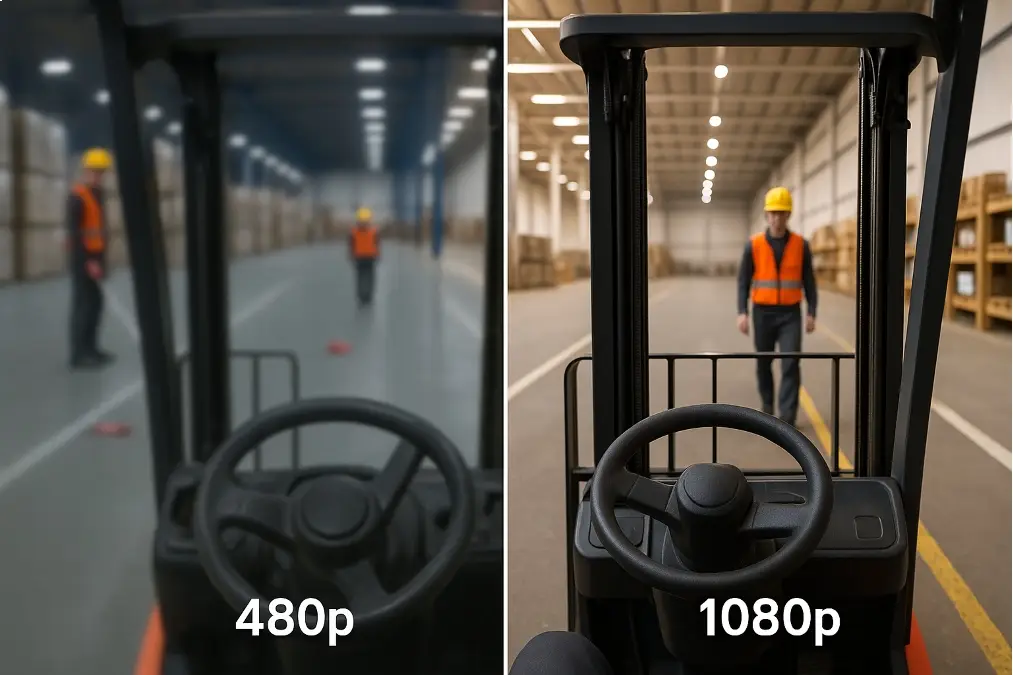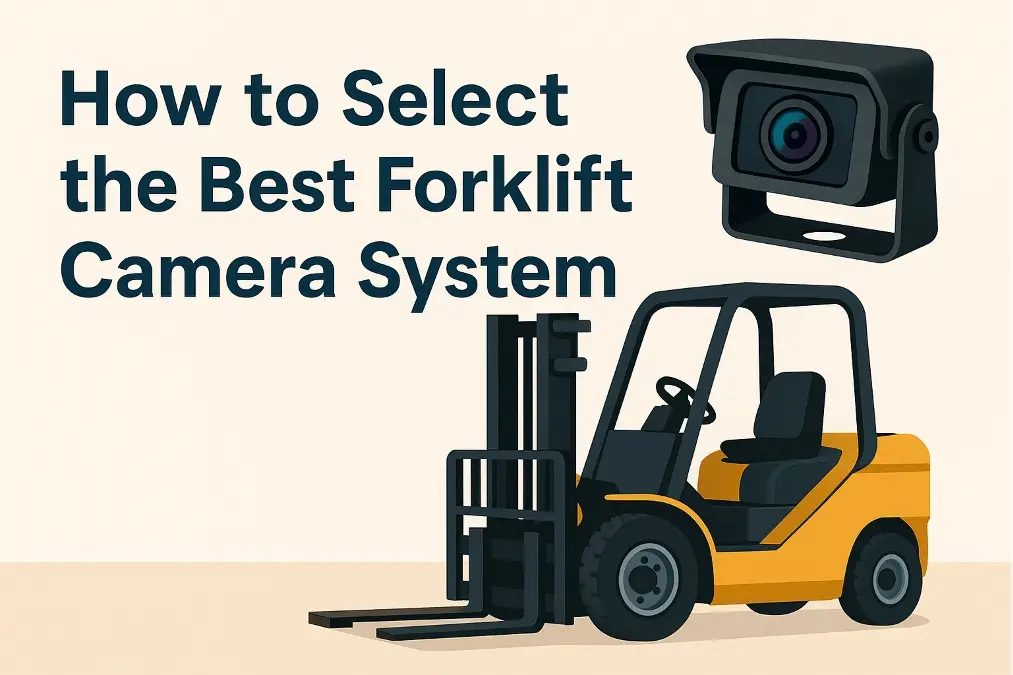Forklift operators face countless challenges in crowded warehouses, from tight aisles to unpredictable foot traffic. When visibility is limited, accidents can happen fast. Choosing the right forklift camera system isn’t just about technology—it’s about protecting people and improving how work gets done.
The best forklift camera system is the one that fits your environment, your safety requirements, and your team’s habits. A well-matched system will make forklifts safer to drive, easier to maneuver, and more reliable in every shift.

Forklift camera systems can make the difference between a near miss and an accident. To make the right choice, you need to look at resolution, integration, camera placement, and smart features. Let’s dig into each area.
How Does Camera Resolution Affect Forklift Safety and Efficiency?
A camera’s resolution is the number of pixels in its image. For forklifts, that pixel count is more than just a number—it determines what the operator can actually see.
High resolution means the operator sees sharp details on the monitor. Small obstacles or workers’ feet in the path won’t blend into the background. That extra clarity gives operators confidence and control, especially in cluttered warehouses or low-light conditions.
With low resolution, details blur together. Operators may miss warning signs or misjudge distances, leading to mistakes. High resolution doesn’t just look better; it lets the operator work faster, park closer, and move loads more accurately.

I remember when we upgraded from standard cameras to HD models. Our team saw fewer incidents right away. Operators could spot a dropped tool or a pallet out of place without leaving their seat. For us, that clarity paid for itself in safety and productivity.
Comparing Camera Resolutions and Their Impact
| 決議 | Typical Use | Visibility | Pros | Cons |
|---|---|---|---|---|
| 480p (SD) | Basic monitoring | Low | Low cost | Blurry image, not for safety |
| 720p (HD) | General warehouse | Good | Affordable, clear | Limited details at distance |
| 1080p (Full HD) | High-traffic areas | Excellent | Crisp image, safe | Needs more storage/data |
| 2MP & up | AI detection, analytics | Superior | Detects small hazards | Higher cost |
How to Integrate Forklift Cameras with Other Safety Devices?
Forklift safety isn’t about one solution. It’s about how all your safety tools work together. Cameras are a strong foundation, but integration with alarms, lights, and sensors takes safety to another level.
Cameras combined with backup alarms let operators see and hear when people are nearby. Add flashing warning lights, and you can alert everyone in the area. Proximity sensors add an extra shield: they detect obstacles even when the camera can’t see them, like a pallet just around a corner.
A modern forklift camera system should connect easily to these safety devices. That way, the camera triggers alarms, records incidents, or even sends live footage to the safety team. All these systems working together can stop accidents before they start.

Once, we had an operator miss seeing someone behind a load—until we added a camera with a linked backup alarm. Now, when the camera spots motion, the alarm goes off. That teamwork between devices has kept our team safe, even in our busiest hours.
Safety Devices Commonly Integrated With Cameras
| Device | Integration Benefit | Real-World Impact |
|---|---|---|
| Backup Alarm | Alerts operator & pedestrians | Reduces backing collisions |
| Warning Lights | Signals motion visually | Increases awareness |
| Proximity Sensor | Detects hidden obstacles | Prevents surprises |
| DVR/Recorder | Stores footage for review | Improves training, evidence |
| Telematics System | Real-time monitoring & alerts | Fast response to hazards |
Where Can Forklift Cameras Be Placed for Optimal Visibility?
Camera placement is everything. If the camera isn’t in the right spot, blind spots remain and risks stay high.
The most effective camera placements include:
- Rearview: For safe reversing, especially in busy aisles.
- Fork/Load View: Mounted on the carriage or fork, showing where the forks are during lifting and loading.
- Side View: On the left or right, to eliminate blind spots and help with tight turns.
- 360° Bird’s Eye: Using multiple cameras stitched together, giving the operator a full view of the forklift’s perimeter.
Monitor placement inside the cab matters, too. It should be right in the operator’s line of sight, so there’s no distraction or need to look away from the path.

I once thought a rearview camera was enough—until a near miss on the side made us add a second camera. That simple change let us catch everything in our operators’ blind spots. Now, we use multiple views and haven’t looked back.
Common Camera Placements and Their Advantages
| Placement | Blind Spots Covered | Best For | Notes |
|---|---|---|---|
| Rearview | Directly behind | Reversing | Most common placement |
| Fork/Load View | Fork tips, load area | Precision loading | Helps with high stacking |
| Side View | Flanks | Turning, narrow aisles | Reduces side collisions |
| 360° Bird’s Eye | All around | Complex environments | Requires multi-camera setup |
What are the Latest Features in AI-Powered Forklift Camera Systems?
AI is changing how forklifts see the world. Old cameras showed a video; new AI-powered cameras interpret the scene and help the operator make smarter, safer decisions.
Some of the latest features include:
- Pedestrian Detection: The camera can spot people, not just objects, and alert the operator with beeps or on-screen signals.
- Object Recognition: AI can identify specific hazards—like a stray pallet or blocked aisle—and warn the operator right away.
- Real-Time Alerts: Instant feedback keeps the operator aware of changing risks, like a fast-approaching person.
- Automated Recording: The camera system records and saves video automatically when an incident or near-miss is detected, helping with investigations and training.
- Integration with Fleet Management: AI cameras send data to managers, offering insights into risky habits or common trouble spots on the warehouse floor.

When we added AI pedestrian detection, we immediately saw fewer close calls. The system “sees” what humans might miss—especially when distracted or tired. It’s like having a second pair of eyes, always watching and always alert.
Key AI Features in Modern Forklift Camera Systems
| Feature | How It Works | Real-World Benefit |
|---|---|---|
| Pedestrian Detection | Highlights people in camera | Prevents run-ins, saves lives |
| Object Recognition | Identifies non-human hazards | Avoids product/equipment damage |
| Real-Time Alerts | Visual/audio signals | Fast operator response |
| Smart Recording | Saves incident footage | Easier training, legal proof |
| Analytics Integration | Shares safety data to managers | Improves warehouse protocols |
結論
Choosing the best forklift camera system means looking beyond price tags. Focus on what the camera lets your team see, how it works with your other safety devices, where it’s placed, and what intelligence it brings to your operations. The right system will pay for itself in fewer accidents, greater efficiency, and peace of mind for everyone in your warehouse.


